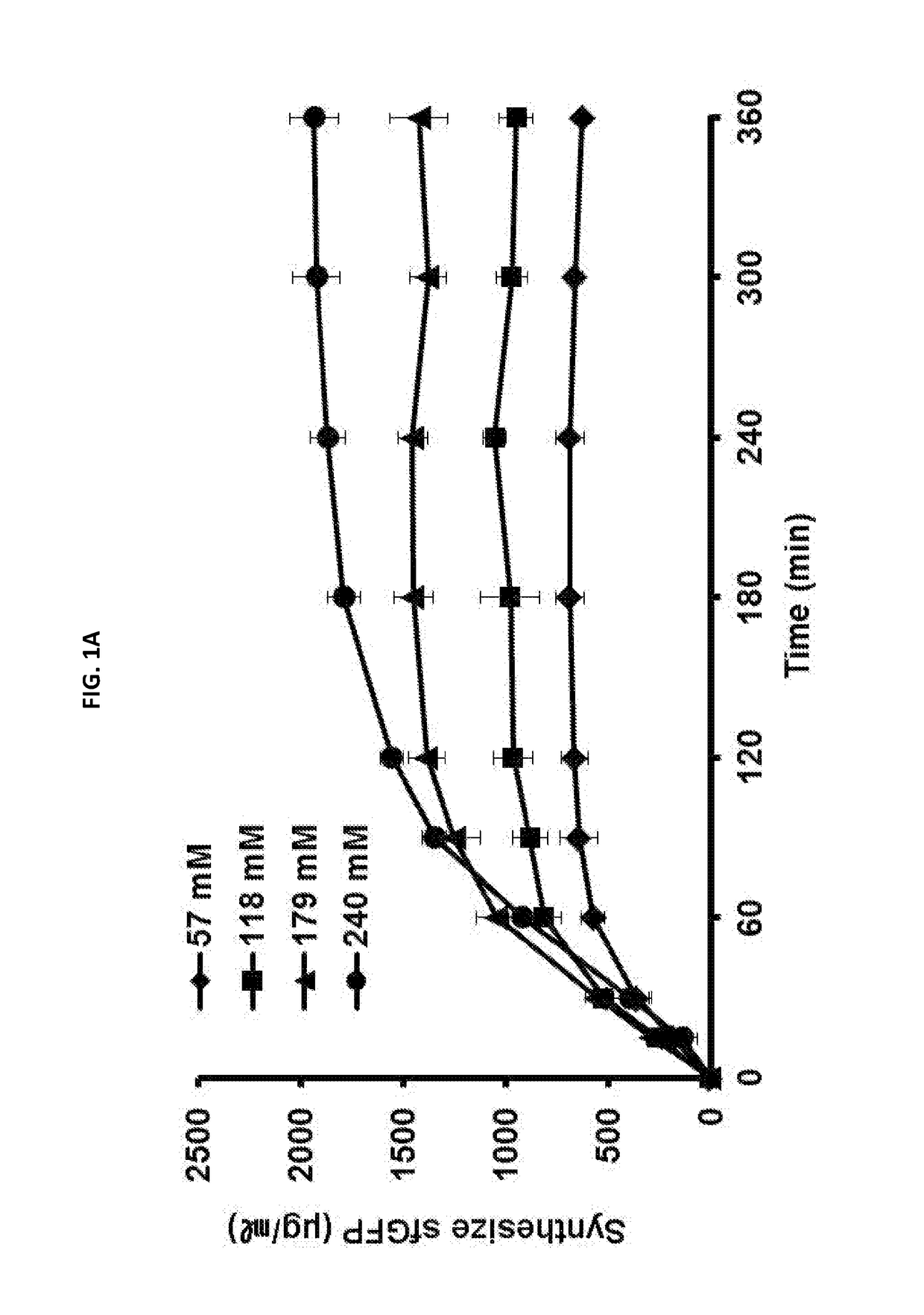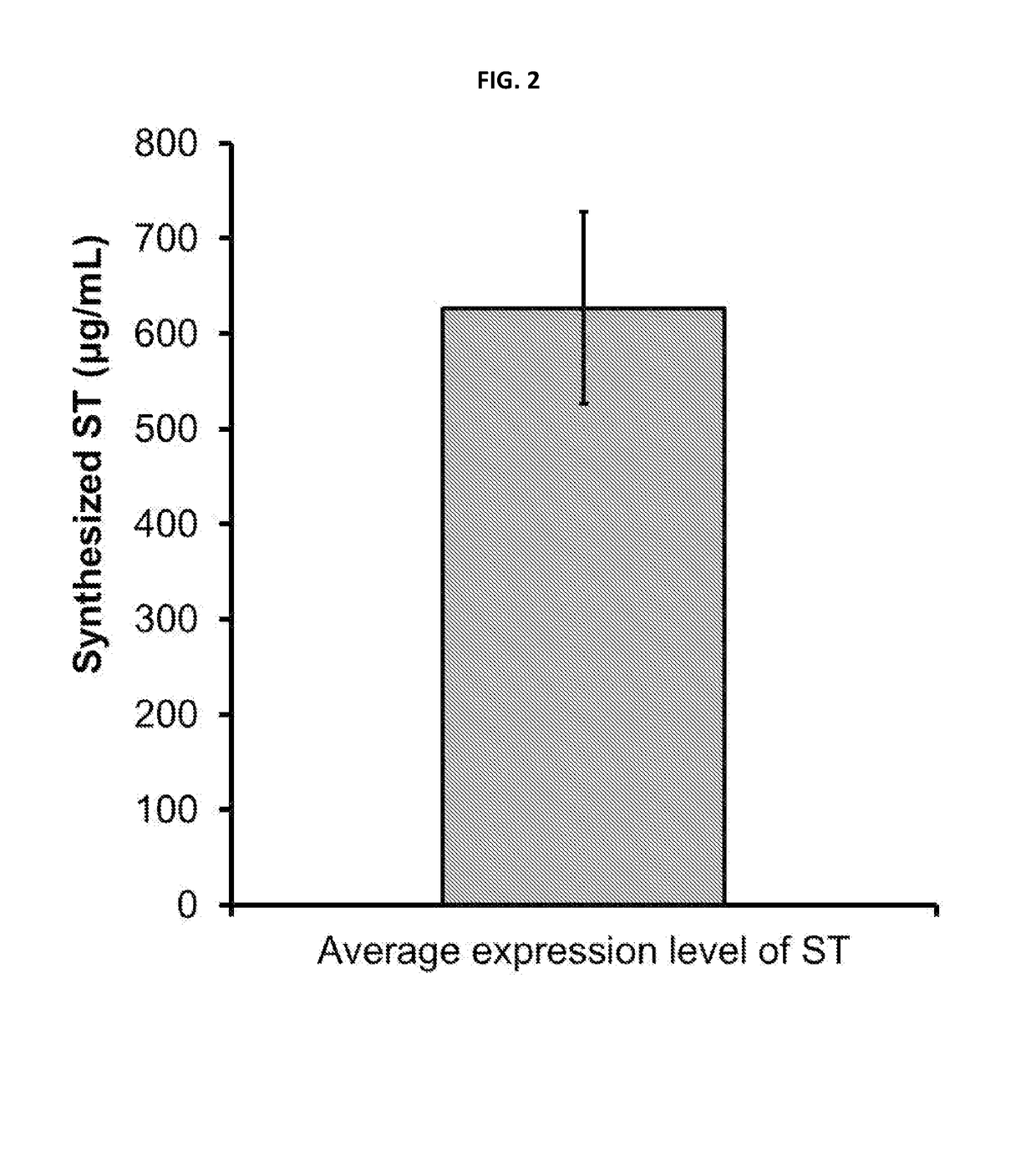METHOD FOR CELL-FREE PROTEIN SYNTHESIS INVOLVED WITH pH CONTROL BY USING ENZYME
a cell-free protein and enzyme technology, applied in the field of cell-free protein synthesis, can solve the problems of inhibiting protein synthesis, poor atp regeneration efficiency, poor protein synthesis efficiency, etc., and achieve the effect of suppressing ph decrease, excellent effect of suppressing protein synthesis and enhancing protein synthesis amoun
- Summary
- Abstract
- Description
- Claims
- Application Information
AI Technical Summary
Benefits of technology
Problems solved by technology
Method used
Image
Examples
example 1
Determination of Amount of Synthesized Protein and Change in pH Depending on Concentration of Buffer Solution of Cell-Free Protein Synthesis
[0053]To determine a pH change depending on the concentration of a buffer solution of cell-free protein synthesis, cell-free protein synthesis of sfGFP protein was carried out by using a buffer solution of 57 mM, 118 mM, 179 mM, or 240 mM.
[0054]As shown in FIGS.1A and 1B, it was found that the decrease amount of pH is reduced and the protein synthesis amount is increased as the concentration of the chemical buffer solution (I.e., HEPES buffer) is increased. At that time, in order to maintain the pH level of 6.5 which is the minimum condition required for the reaction using an excess amount of glucose (80 mM), concentration of the buffer solution (I.e., HEPES buffer) was optimized, i.e., 240 mM or less. As a result of carrying out the cell-free protein synthesis at a condition including 240 mM buffer solution, it was confirmed that sfGFP protein ...
example 2
Determination of Effect of Controlling pH Change by Glutamic Acid Decarboxylase in Cell-Free Protein Synthesis and Expression Amount of sfGFP Protein
[0059]As a buffer mechanism which exhibits no interference in activity analysis under pH control of cell-free protein synthesis, an amino acid decarboxylase was used.
[0060]Numerous microorganisms have an intrinsic buffer system for their survival at acidic conditions. For example, in case of E. coli, several kinds of an amino acid decarboxylase (i.e., arginine decarboxylase, glutamic acid decarboxylase, and lysine decarboxylase) are induced and expressed at acidic conditions. Those enzymes are known to remove hydrogen ions while dissociating the carboxyl group from each amino acid and have a function of maintaining intracellular pH of E. coli even at acidic conditions. By taking advantage of such characteristics, the anti-acidic mechanism of those microorganisms was applied to control the pH change in a cell-free protein synthesis syste...
example 3
Establishment, Expression, and Activity Analysis of Sialyl Transferase Library
[0071]In this Example 3, establishment of a sialyl transferase library, cell-free protein synthesis using an amino acid decarboxylase, and an assay for analyzing the activity of synthesized enzyme were performed according to the process shown in FIG. 7.
[0072]In Example 3, according to a method for cell-free protein synthesis which is characterized in that pH is controlled by using glutamic acid decarboxylase (GAD) and glutamic acid, about 10,000 gene libraries were expressed and activity of the expressed proteins was screened (FIG. 8).
[0073]As illustrated in FIG. 9, it was confirmed that the mutant sialyl transferases, which have been obtained by cell-free protein synthesis by using the GAD system in which pH is controlled using glutamic acid decarboxylase (GAD) and glutamic acid, are synthesized at the almost same level. Accordingly, it was found that the result of the activity analysis which is obtained ...
PUM
| Property | Measurement | Unit |
|---|---|---|
| temperature | aaaaa | aaaaa |
| pH | aaaaa | aaaaa |
| constant pressure | aaaaa | aaaaa |
Abstract
Description
Claims
Application Information
 Login to View More
Login to View More - R&D
- Intellectual Property
- Life Sciences
- Materials
- Tech Scout
- Unparalleled Data Quality
- Higher Quality Content
- 60% Fewer Hallucinations
Browse by: Latest US Patents, China's latest patents, Technical Efficacy Thesaurus, Application Domain, Technology Topic, Popular Technical Reports.
© 2025 PatSnap. All rights reserved.Legal|Privacy policy|Modern Slavery Act Transparency Statement|Sitemap|About US| Contact US: help@patsnap.com



